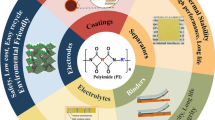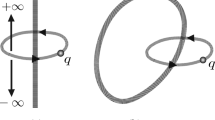Abstract
When a straight conductor of finite length is connected to a battery, the positive and negative charges on the upper and lower plates of the conductor induce an electric field and a current in the conductor. In the conventional method, it is assumed that the internal electric field is uniform as steady current flows in the conductor. However, the electric field is induced by electric charges but not by currents. A steady current can flow in a wire when guided by charge accumulated on the surface of the conductor. Although the existence of surface charge has been confirmed in several studies, an analytical approach to determine the surface charge distribution was successful only when the conductor was considered infinitely long. Numerical methods were used to compute the electric flux incident on the conductor surface and to determine the surface charge that balances the incoming electric flux. However, the relationship between the incoming electric flux and the surface charge has not been established in a closed form. In this study, the conduction current is considered to be the relaxation of the electrode and surface charges and is treated as the sum of the electric fluxes entering and leaving the conductor surface. The relationship between the incoming electric flux and surface charge is obtained in a closed form by applying the continuity equation and boundary conditions for the electric field at the interface between two dissimilar materials. This relationship is applicable to any interface, including conductor-conductor and lossy dielectric-dielectric interfaces. A two-dimensional model of a current-carrying wire is developed using slab conductors to numerically compute the surface charge densities, electric fields, and equipotential surfaces inside and outside the conductor. Our results show that the charge peaks at the corners of the conductor and at the point where two dissimilar conductors meet.








Similar content being viewed by others
References
Marcus A (1941) The electric field associated with a steady current in long cylindrical conductor. Am J Phys 9(4):225–226
Sommerfeld A (1952) Electrodynamics. Academic, New York, pp 125–130
Jackson JD (1996) Surface charges on circuit wires and resistors play three roles. Am J Phys 64(7):855–870
Sarachman TN (1969) The electric field outside a long straight wire carrying a steady current. Am J Phys 37(7):748
Stoeckly R (1970) Comment on the electric field outside a long straight wire carrying a steady current. Am J Phys 38(7):934–935
Marcuse D (1970) Comment on the electric field outside a long straight wire carrying a steady current. Am J Phys 38(7):935–936
Scott WT (1970) Equipotentials outside a long straight wire carrying a steady current. Am J Phys 38(7):936
Merzbacher E (1980) A puzzle from professor Eugen Merzbacher. Am J Phys 48:178
Heberle J (1981) On the puzzle of Merzbacher. Am J Phys 49(1):81
Varney RN, Fisher LH (1984) Electric fields associated with stationary currents. Am J Phys 52(12):1097–1099
Jefimenko O (1962) Demonstration of the electric fields of current-carrying conductors. Am J Phys 30:19–21
Parker S (1970) Electrostatics and current flow. Am J Phys 38(6):720–723
Moreau WR, Ryan SG, Beuzenberg SJ, Syme RWG (1985) Charge density in circuits. Am J Phys 53:552–553
Jacobs R, de Salazar A, Nassar A (2010) New experimental method of visualizing the electric field due to surface charges on circuit elements. Am J Phys 78(12):1432–1433
Russell BR (1968) Surface charge on conductors carrying steady currents. Am J Phys 36(6):527–529
Heald MA (1984) Electric fields and charges in elementary circuits. Am J Phys 52(6):522–526
Hernandes JA, Assis AKT (2003) The potential, electric field and surface charges for a resistive long straight strip carrying a steady current. Am J Phys 71(9):938–942
Galili I, Goihbarg E (2005) Energy transfer in electric circuits: A qualitative account. Am J Phys 73(2):141–144
Harbola MK (2010) Energy flow from a battery to other circuit elements: Role of surface charges. Am J Phys 78(11):1203–1206
Davis BS, Kaplan L (2011) Poynting vector flow in a circular circuit. Am J Phys 79(11):1155–1162
Muller R (2012) A semiquantitative treatment of surface charges in DC circuits. Am J Phys 80(9):782–788
Preyer NW (2000) Surface charges and fields of simple circuits. Am J Phys 68(11):1002–1006
Preyer NW (2002) Transient behavior of simple RC circuits. Am J Phys 70(12):1187–1193
Chabay R, Sherwood B (2019) Polarization in electrostatics and circuits: computing and visualizing surface charge distributions. Am J Phys 87(5):341–349
Klee MM (2020) Surface charges from a sensing pixel perspective. Am J Phys 88(8):649–660
Rosser WGV (1963) What makes an electric current flow. Am J Phys 31(11):884–885
Funding
This work was supported by the Basic Science Research Program through NRF Korea under the grant NRF-2021R1F1A1051278.
Author information
Authors and Affiliations
Corresponding author
Ethics declarations
Conflict of interest
The author has no competing interests to declare that are relevant to the content of this article.
Additional information
Publisher's Note
Springer Nature remains neutral with regard to jurisdictional claims in published maps and institutional affiliations.
Rights and permissions
Springer Nature or its licensor (e.g. a society or other partner) holds exclusive rights to this article under a publishing agreement with the author(s) or other rightsholder(s); author self-archiving of the accepted manuscript version of this article is solely governed by the terms of such publishing agreement and applicable law.
About this article
Cite this article
Lee, Y.H. Electric Flux Approach for Surface Charges on Current Carrying Conductor. J. Electr. Eng. Technol. 19, 443–451 (2024). https://doi.org/10.1007/s42835-023-01546-4
Received:
Revised:
Accepted:
Published:
Issue Date:
DOI: https://doi.org/10.1007/s42835-023-01546-4




